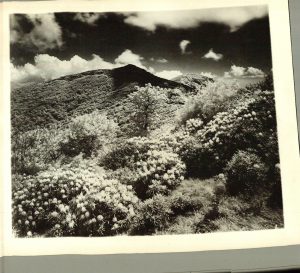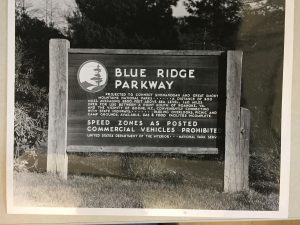Cutting through the heart of the Blue Ridge Mountains, the winding 469 mile trail of the Blue Ridge Parkway (BRP) through Western North Carolina (WNC) is a familiar sight for most people. It has long provided visitors with an array of beautiful marvels: the hazy blue of the mountains that seem to disappear on the horizon, a sea of red and gold and orange and every color in between, a variety of flora and fauna, waterfalls and mountain trails and overlooks. The story of the Blue Ridge Parkway is a long one, full of character and color (just like the road itself)!

Craggy Gardens. Courtesy of the Blue Ridge Parkway Archives.[1]

Entrance Sign for the Blue Ridge Parkway. [2]
For a very brief overview of the history of the Blue Ridge Parkway from conception to completion, please refer to the timeline that can be found below this paragraph. The timeline uses newspaper articles to highlight a couple of events from the Parkway’s history. Also, it’s just fun to look at historical documents. To better understand some of the terms and acronyms that used throughout this website, the acronyms and definitions are listed Glossary page. Please refer to this whenever there is an abbreviation that is confusing.
UP NEXT: Construction of the Blue Ridge Parkway
The following footnotes are for the Blue Ridge Parkway timeline. They are organized in order of how they appear on the timeline, from earliest to most recent print date.
EmilyDawn2, Blue Rige Parkway, digital image, Pixdaus, accessed September 29, 2017, http://pixdaus.com/files/items/pics/5/31/80531_3645ce3db3695673d61bd479bc003c67_large.jpg.
“Mr. Ickes With Us,” Statesville Record and Landmark, November 15, 1934, accessed September 29, 2017, https://www.newspapers.com/clip/14073764/statesville_record_and_landmark/.
“Browning,” Daily Tar Heel, February 8, 1935, accessed September 18, 2017 https://www.newspapers.com/clip/13852828/the_daily_tar_heel/.
“Parkway Fund is Restored,” Statesville Record and Landmark, October 7, 1935, accessed September 19, 2017, https://www.newspapers.com/clip/13868716/statesville_record_and_landmark/.
“Scenic Blue Ridge Parkway Fast Becoming Reality in N.C., Virginia Reports Ickes,” Daily Times- News, April 14, 1938, accessed September 22, 2017, https://www.newspapers.com/clip/13924973/the_daily_timesnews/.
“Frank Dunlap Urges Survey in Blue Ridge,” Daily Times- News, October 19, 1939, accessed September 19, 2017, https://www.newspapers.com/clip/13874192/the_daily_timesnews/.
“Kansan Assails Blue Ridge Project But Bill Approved,” Daily Times- News, February 9, 1940, accessed September 29, 2017, https://www.newspapers.com/clip/14073861/the_daily_timesnews/.
“Barkleys Have A Family Outing,” Statesville Record and Landmark, July 10, 1947, accessed September 28, 2017, https://www.newspapers.com/clip/14062097/statesville_record_and_landmark/.
“Parkway Plans Not Completed: Great Smoky Playground Still Far Short Of Main Objectives Of Its Sponsors,” Gastonia Gazette, January 29, 1948, accessed September 29, 2017, https://www.newspapers.com/clip/14074444/the_gastonia_gazette/.
Lynn Nesbit, “Capitol Square,” Statesville Daily Record, October 12, 1951, accessed September 19, 2017, https://www.newspapers.com/clip/13874316/statesville_daily_record/.
Lynn Nesbit, “Around Capitol Square,” Robesonian, May 28, 1953, accessed September 29, 2017, https://www.newspapers.com/clip/14074594/the_robesonian/.
Holt McPherson, “Good Afternoon,” High Point Enterprise, June 8, 1961, accessed September 19, 2017, https://www.newspapers.com/clip/13874431/the_high_point_enterprise/.
“Alexander Is Opposed To Federal ‘User’ Tax,” Statesville Daily Record and Landmark, July 19, 1962, accessed October 6, 2017, https://www.newspapers.com/clip/14225449/statesville_record_and_landmark/.
“Morton Gives Deed To State For Parkway,” Statesville Record and Landmark, October 23, 1968, accessed October 6, 2017, https://www.newspapers.com/clip/14233827/statesville_record_and_landmark/.
“Parkway To Be Completed,” High Point Enterprise, December 17, 1977, accessed September 19, 2017, https://www.newspapers.com/clip/13874611/the_high_point_enterprise/.
Header Image Citation:
Jennifer Mesk, North of Waterrock Knob, Milepost 451.2, October 11, 2016, Blue Ridge Parkway Fall Colors, accessed October 26, 2017, http://www.blueridgeparkwaydaily.com/north-of-waterrrock-knob/.
Footnotes
[1] Craggy Gardens, Record Group 11, Box 11, Folder 38, Blue Ridge Parkway Archives, Asheville, North Carolina.
[2] Entrance Sign for the Blue Ridge Parkway, Unlabeled Box, No Provenance, Blue Ridge Parkway Archives, Asheville, North Carolina.
